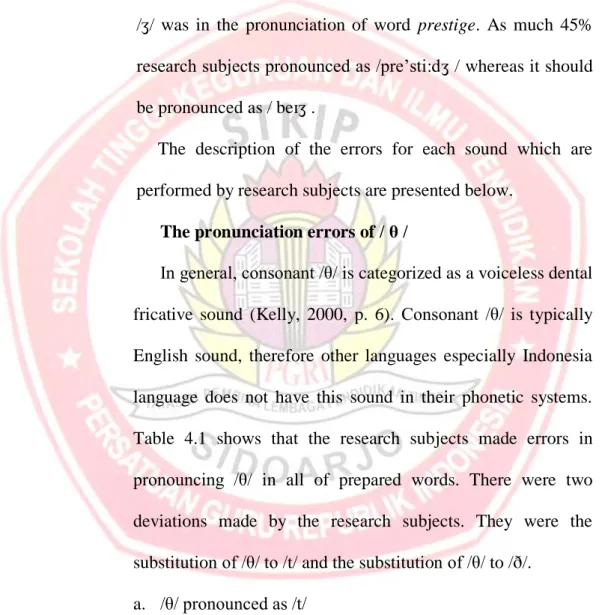In the first question of the interview, the researcher asked them about the importance of pronunciation for them. In the second interview question, the researcher asked them about the correlation between good pronunciation and self-confidence. The third question of the interview, the researcher asked them about the correlation between good pronunciation and.
In the sixth question of the interview, the researcher asked them about their difficulties in learning pronunciation. The eighth question of the interview the researcher asked them about the theory of producing the sounds (θ/, /ð/, /ʒ/, /ʤ/, /ʧ). The tenth question of the interview the researcher asked them about their activeness in learning pronunciation.
Based on the interview, all the interviewees state that they actively learned during the pronunciation lessons. In the eleventh interview question, the researcher asked them about their confidence in speaking English. In the fourteenth question of the interview, the researcher asked them about the consistency of speaking English in good pronunciation.
Based on the interview, all interviewees indicate that they do not always speak English with good pronunciation.

Discussion
Discussion of the Frequent Errors in Consonant Production
Most errors made by the research subjects change the sound from voiceless dental fricative consonant /θ/ to voiceless alveolar stop consonant /t/. However, the research subjects pronounced the sound /θ/ as /t/ through the tongue coming into contact with the alveolar ridge (alveolar sound) and the airflow is firmly stopped when it is released, there is a plosive (stopping sound). However, the research subjects pronounced the sound of /θ/ as /ð/ which was produced with vibration on the vocal cords (vocal sound).
Most of the errors made by the research subjects are changing the sound of voiced dental fricative consonants /ð/ to voiced alveolar stop consonants /d/. However, the research subjects pronounced the /ð/ sound as /d/ with the tongue contacting the alveolar ridge (alveolar sound) and the airflow stopping sharply when a plosive is released (stop sound). The errors made by the research subjects are changing the sound of voiced dental fricative consonants /ð/ to voiceless palatal fricative consonants /ʃ/.
The subjects produced the sound well in terms of point and mode of articulation. The errors made by the subjects replaced the sound of voiced palato-alveolar fricative consonant /ʒ/ with voiced alveolar fricative /z/. The errors made by subjects change the sound of the voiced palato-alveolar fricative consonant /ʒ/ into the voiceless alveolar fricative consonant /s/.
The errors made by subjects were to change the sound of voiced palato-alveolar fricative consonant /ʒ/ to voiced palato-alveolar affricate consonant /ʤ/. Subjects changed the sound of voiced palato-alveolar fricative consonant /ʒ/ to voiceless palato-alveolar affricate consonant /ʧ/. The errors made by subjects substituted the sound of voiced palato-alveolar fricative consonant /ʒ/.
The researchers' mistakes were replacing the sound of the palatoalveolar affricate consonant /ʤ/ with the palatal stop consonant /j/. For the point of articulation, the palato-alveolar sound was replaced by a palatal sound. The sound was produced by bringing the tongue into contact with the alveolar ridge (alveolar sound). The sound /ʤ/ must be pronounced.
In this deviation, the research subjects replaced the sound of voiced palato-alveolar affricate consonant /ʤ/ to voiced velar stop consonant /g/. The errors made by research subjects were the substitution of the sound of voiceless palato-alveolar affricate consonant /ʧ/ to voiceless palatal stop consonant /c/.

The Discussion of Causes of Errors in Consonant Production
Both of these consonants were produced without vibration on the vocal cords (voiceless sound). They produced the sound of /ʧ/ by raising the back of the tongue to the soft palate (velar sound). The sound of /ʧ/ must be pronounced by curling the tongue behind the alveolar ridge or called by palato-alveolar sound (Kelly, 2000, p. 6).
They produced the sound by stopping the airflow and when it was released there was a plosive (stop sound), while they had to pronounce the sound by not stopping the airflow and there was a hissing sound (affricate sound). Finding causes of pronunciation errors in this study confirmed Biyaem's theory in (Khan & Qadir, 2012) on factors in pronunciation errors. Based on the interview, all interviewees stated that good pronunciation was important to them because it could increase their self-confidence and avoid misunderstandings between speakers and listeners.
In fact, they had some difficulty in learning the pronunciation and made mistakes while doing so. The first cause of errors was the difference in the spelling system of English and Indonesia when pronouncing words. In addition, not all interviewees had much time to practice English pronunciation or to repeat the lesson.
They also stated that they rarely opened a dictionary or checked phonetic spelling symbols when they encountered unfamiliar words. Based on the interview, all interviewees stated that they also had difficulties in learning pronunciation as some sounds did not exist in Indonesia and the difference sounds between English and Indonesian. Furthermore, 60% of the interviewees stated that they did not really understand the theory of sound production (θ/, /ð/, /ʒ/, /ʤ/, /ʧ).
They got the theory from the teacher in the pronunciation and phonology class when they were in the third term, but now they almost forget the theory as they have never polished the books. Based on the interview, all interviewees stated that they were disturbed from their mother tongue in pronouncing some English words, as English was a new language for them like Indonesian. Some research subjects pronounced the English words using their native language system, sometimes replacing the sounds with similar words in their native language.